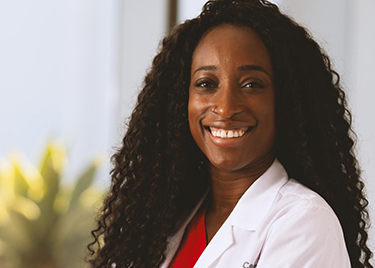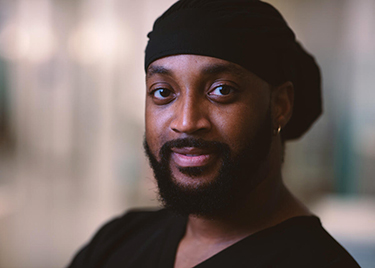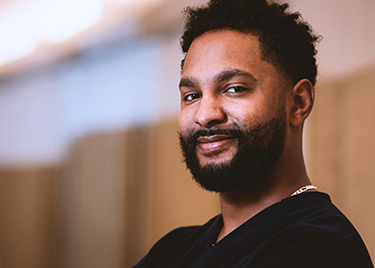Cedars-Sinai Blog
The Next Generation of Black Healthcare Leaders
Feb 28, 2024 Amy Paturel
Freshly minted physicians from all over the country are drawn to Cedars-Sinai’s commitment to growing a diverse and inclusive workforce.
“One of the goals on our journey to become a national model for diversity, equity and inclusion (DEI) is to provide resources and opportunities for advanced training, education and career development for all people, especially those from historically underrepresented groups,” said Nicole M.B. Mitchell, chief diversity officer in Cedars-Sinai’s Office of Diversity, Inclusion and Wellbeing.
Hailing from Brooklyn to Detroit, four Black physicians share how they found their way to Cedars-Sinai and the difference they hope to make in DEI within the institution and beyond.

Dr. Mariam Alaka has become the physician she wished she had seen as a child.
Breaking Through: I grew up on the south side of Chicago as the daughter of immigrants. My mom stayed at home with me and my siblings, and my dad worked in a computer store. Even though I lived in a predominantly Black neighborhood, I never saw a Black doctor. I was always interested in science, but it was hard to imagine myself as a doctor. I explored many science careers, but I solidified my goal to be a doctor during college when I spent my free time volunteering and shadowing medical professionals in the hospital.
Finding My Specialty: I selected the University of Chicago for medical school because I wanted to give back to the community where I grew up and gain experience working in underserved neighborhoods. I always thought I would be an obstetrics and gynecology doctor. Then I took a year off to do research in Nigeria. When I came back, I did an emergency medicine rotation in Cook County, which requires a broad knowledge base, caring for patients when they’re most vulnerable and serving a diverse population—including immigrants from all over the world. That’s when I knew I wanted to be an emergency medicine physician. I just really enjoy saving lives.
Heading Into the Future: People still don’t expect to see a physician who is Black, female and in her early 30s working in the emergency room. I get to be the face of the physician I wish I’d had as a child. My signature is to wear bright-colored scrubs. I want to be visible, to bring color into a place that can feel dark and stressful to patients. Cedars-Sinai affords me the resources to care for patients beyond the emergency room. I don’t have to discharge an uninsured patient without a life preserver. I can put in an order for social work, case management or even a primary care follow-up, which leads to greater satisfaction for both the patient and me.

Dr. DeSean Thom aims to help future generations achieve their dreams.
Living the Dream: I was born in Brooklyn, raised in Virginia Beach, and I ultimately became the first in my family of West-Indian immigrants to attend a traditional four-year university and then become a physician. My mom, a public health nurse, insisted on self-reliance and education. She went out of her way to create opportunities for me not only to pursue different interests from sports to music, but also to connect me with people from different cultures and backgrounds.
Finding My Specialty: As soon as I stepped into the operating room during my Obstetrics and Gynecology rotation, I knew that I was going to pursue anesthesia or surgery. Over time, anesthesia seemed to fall most in line with my skillset and compassionate nature. Within 15 minutes, you meet a patient for the first time, obtain a complete medical history and make them feel comfortable amid a very anxiety-provoking situation.
Heading Into the Future: With my background, I appreciate the health disparities that are present not only in the United States but also around the world. I would love to be able to use the resources and access that I’ve had to help bridge that gap. I would like to build international partnerships where I can use my expertise to help alter the trajectory of future generations, so there’s never a ceiling to the dreams and desires of what people can accomplish.
"Our goal is to become a national model for DEI by providing resources and opportunities for advanced training, education and career development to people from historically underrepresented groups."

Dr. Jalen Dansby plans to use his platform as a surgeon to advocate for social justice.
Building a Scaffold: As a football player at Vanderbilt University, I stumbled to the sidelines in pain after dislocating my shoulder for the 10th time in two years. That still wasn’t as challenging or painful as the 10 times my family relocated during my childhood. But I grew to appreciate that living in Dallas, St. Louis, Houston, Baltimore and Detroit exposed me to diverse people and experiences that serve me well as a physician. Some of my earliest playmates were first-generation immigrants from Mexico, Ethiopia, Nigeria and Romania. Like many Black males, I aspired to become a professional athlete like figures portrayed in the media. Then I attended my eldest sister’s “white coat ceremony” at Howard Medical School and saw the diversity of high-achieving students obtaining their own white coats. I began to think a career in medicine might be possible for me, too.
Finding My Specialty: I have been fascinated with musculoskeletal issues from a young age, and as a multi-sport athlete, I had plenty of firsthand experience with orthopedic injuries. I learned from experience how a single surgery can dramatically improve an individual’s quality of life by restoring function and resolving pain—and I resolved to pursue a career in orthopedics.
Heading Into the Future: As a Black male in medicine, I am standing on the shoulders of giants that carried a heavier weight through even more difficult times. I feel an obligation to use my platform as a surgeon to pave the way for others and advocate for social justice. Whether on the football field, in the classroom or in the hospital, teams operate most effectively when they encompass and embrace diversity. I plan to use my education and training to be a force in the growing push to improve health systems and patient care for the historically underrepresented groups I encountered throughout my traveling childhood.
Living the Dream: Both of my parents are immigrants from Jamaica, and they instilled a strong work ethic in me and my siblings. My dad is a mechanic and my mom is a nurse, so I learned a lot about healthcare from my mom when I was growing up in New York. I always wanted to be a doctor, and when my eldest brother became a surgeon, that had a big impact on me. I thought I’d follow in his footsteps.
Finding My Specialty: I didn’t know much about anesthesiology when I started medical school. It’s not a specialty many people talk about, but when I did rotations, I found that I really enjoyed the field. It allowed me to be in the operating room but manage patient care with a different lens. I love the instant gratification that comes from my subspecialty of regional anesthesia. I can give patients a nerve block and relieve their pain on the spot.
Heading Into the Future: Minorities are still underrepresented in medicine, and in many other fields. So it’s important to me to be a role model for future physicians. When we shine a spotlight on diversity and inclusion, everyone wins.


